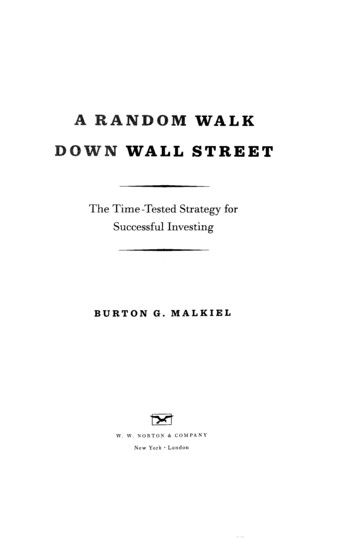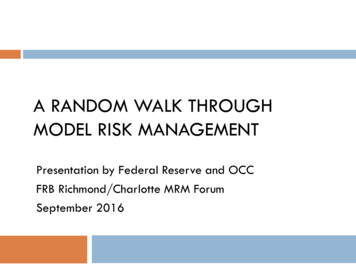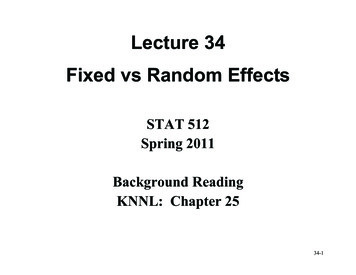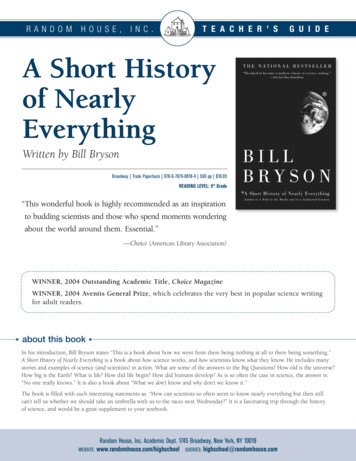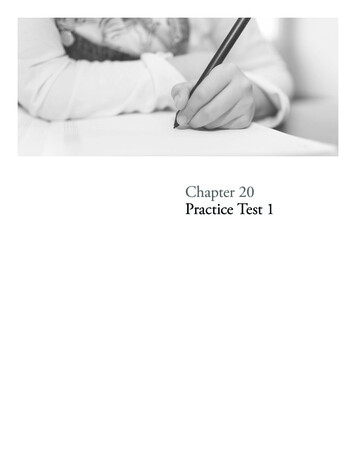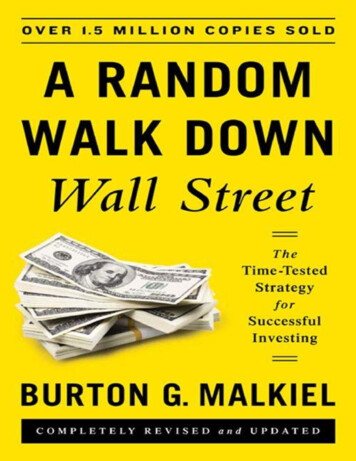
Transcription
A RANDOM WALKDOWN WALL STREETThe Time-Tested Strategy forSuccessful InvestingBURTON G. MALKIELW. W. NORTON & COMPANYNew York London
FOR NANCY AND PIPER
CONTENTSPrefacePart OneSTOCKS AND THEIR VALUE1. FIRM FOUNDATIONS AND CASTLES IN THE AIRWhat Is a Random Walk?Investing as a Way of Life TodayInvesting in TheoryThe Firm-Foundation TheoryThe Castle-in-the-Air TheoryHow the Random Walk Is to Be Conducted2. THE MADNESS OF CROWDSThe Tulip-Bulb CrazeThe South Sea BubbleWall Street Lays an EggAn Afterword3. SPECULATIVE BUBBLES FROM THE SIXTIES INTO THE NINETIESThe Sanity of InstitutionsThe Soaring SixtiesThe New “New Era”: The Growth-Stock/New-Issue CrazeSynergy Generates Energy: The Conglomerate BoomPerformance Comes to the Market: The Bubble in Concept StocksThe Nifty FiftyThe Roaring EightiesThe Return of New IssuesConcepts Conquer Again: The Biotechnology BubbleZZZZ Best Bubble of AllWhat Does It All Mean?The Japanese Yen for Land and Stocks4. THE EXPLOSIVE BUBBLES OF THE EARLY 2000s
The Internet BubbleA Broad-Scale High-Tech BubbleYet Another New-Issue CrazeTheGlobe.comSecurity Analysts peak UpNew Valuation MetricsThe Writes of the MediaFraud Slithers In and Strangles the MarketShould We Have Known the Dangers?The U.S. Housing Bubble and Crash of the Early 2000sThe New System of BankingLooser Lending StandardsThe Housing BubbleBubbles and Economic ActivityDoes This Mean That Markets Are Inefficient?Part TwoHOW THE PROS PLAY THE BIGGEST GAME IN TOWN5. TECHNICAL AND FUNDAMENTAL ANALYSISTechnical versus Fundamental AnalysisWhat Can Charts Tell You?The Rationale for the Charting MethodWhy Might Charting Fail to Work?From Chartist to TechnicianThe Technique of Fundamental AnalysisThree Important CaveatsWhy Might Fundamental Analysis Fail to Work?Using Fundamental and Technical Analysis Together6. TECHNICAL ANALYSIS AND THE RANDOM-WALK THEORYHoles in Their Shoes and Ambiguity in Their ForecastsIs There Momentum in the Stock Market?Just What Exactly Is a Random Walk?Some More Elaborate Technical SystemsThe Filter SystemThe Dow TheoryThe Relative-Strength System
Price-Volume SystemsReading Chart PatternsRandomness Is Hard to AcceptA Gaggle of Other Technical Theories to Help You Lose MoneyThe Hemline IndicatorThe Super Bowl IndicatorThe Odd-Lot TheoryDogs of the DowJanuary EffectA Few More SystemsTechnical Market GurusWhy Are Technicians Still Hired?Appraising the CounterattackImplications for Investors7. HOW GOOD IS FUNDAMENTAL ANALYSIS? THE EFFICIENT-MARKETHYPOTHESISThe Views from Wall Street and AcademiaAre Security Analysts Fundamentally Clairvoyant?Why the Crystal Ball Is Clouded1. The Influence of Random Events2. The Production of Dubious Reported Earnings through “Creative”Accounting Procedures3. Errors Made by the Analysts Themselves4. The Loss of the Best Analysts to the Sales Desk, to PortfolioManagement, or to Hedge Funds5. The Conflicts of Interest between Research and Investment BankingDepartmentsDo Security Analysts Pick Winners? The Performance of the Mutual FundsThe Semi-Strong and Strong Forms of the Efficient-Market Hypothesis(EMH)A Note on High-Frequency Trading (HFT)Part ThreeTHE NEW INVESTMENT TECHNOLOGY8. A NEW WALKING SHOE: MODERN PORTFOLIO THEORYThe Role of RiskDefining Risk: The Dispersion of Returns
Illustration: Expected Return and Variance Measures of Reward and RiskDocumenting Risk: A Long-Run StudyReducing Risk: Modern Portfolio Theory (MPT)Diversification in Practice9. REAPING REWARD BY INCREASING RISKBeta and Systematic RiskThe Capital-Asset Pricing Model (CAPM)Let’s Look at the RecordAn Appraisal of the EvidenceThe Quant Quest for Better Measures of Risk: Arbitrage Pricing TheoryThe Fama-French Three-Factor ModelA Summing Up10. BEHAVIORAL FINANCEThe Irrational Behavior of Individual InvestorsOverconfidenceBiased JudgmentsHerdingLoss AversionPride and RegretBehavioral Finance and SavingsThe Limits to ArbitrageWhat Are the Lessons for Investors from Behavioral Finance?1. Avoid Herd Behavior2. Avoid Overtrading3. If You Do Trade: Sell Losers, Not Winners4. Other Stupid Investor TricksDoes Behavioral Finance Teach Ways to Beat the Market?11. IS “SMART BETA” REALLY SMART?What Is “Smart Beta”?Four Tasty Flavors: Their Pros and Cons1. Value Wins2. Smaller Is Better3. Momentum and Reversion to the Mean4. Low Volatility Can Produce High ReturnsBlended Flavors and Strategies“Smart Beta” Funds Flunk the Risk TestAppraisal of “Smart Beta”
How Well Have Factor Tilts Worked in Practice?Value and Size TiltsBlended Hybrid StrategiesResearch Affiliates Fundamental Index (RAFI)Equally Weighted Portfolio StrategiesOther Factor TiltsLow-Beta (Low-Volatility) StrategiesMomentum StrategiesImplications for InvestorsImplications for Believers in Efficient MarketsCapitalizationWeighted Indexing Remains at the Top of the ClassPart FourA PRACTICAL GUIDE FOR RANDOM WALKERS AND OTHER INVESTORS12. A FITNESS MANUAL FOR RANDOM WALKERS AND OTHER INVESTORSExercise 1: Gather the Necessary SuppliesExercise 2: Don’t Be Caught Empty-Handed: Cover Yourself with CashReserves and InsuranceCash ReservesInsuranceDeferred Variable AnnuitiesExercise 3: Be Competitive—Let the Yield on Your Cash Reserve KeepPace with InflationMoney-Market Mutual Funds (Money Funds)Bank Certificates of Deposit (CDs)Internet BanksTreasury BillsTax-Exempt Money-Market FundsExercise 4: Learn How to Dodge the Tax CollectorIndividual Retirement AccountsRoth IRAsPension PlansSaving for College: As Easy as 529Exercise 5: Make Sure the Shoe Fits: Understand Your InvestmentObjectivesExercise 6: Begin Your Walk at Your Own Home—Renting Leads toFlabby Investment Muscles
Exercise 7: How to Investigate a Promenade through Bond CountryZero-Coupon Bonds Can Be Useful to Fund Future LiabilitiesNo-Load Bond Funds Can Be Appropriate Vehicles for Individual InvestorsTax-Exempt Bonds Are Useful for High-Bracket InvestorsHot TIPS: Inflation-Indexed BondsShould You Be a Bond-Market Junkie?Foreign BondsExercise 7A: Use Bond Substitutes for Part of the Aggregate BondPortfolio during Eras of Financial RepressionExercise 8: Tiptoe through the Fields of Gold, Collectibles, and OtherInvestmentsExercise 9: Remember That Investment Costs Are Not Random; Some AreLower Than OthersExercise 10: Avoid Sinkholes and Stumbling Blocks: Diversify YourInvestment StepsA Final Checkup13. HANDICAPPING THE FINANCIAL RACE: A PRIMER IN UNDERSTANDING ANDPROJECTING RETURNS FROM STOCKS AND BONDSWhat Determines the Returns from Stocks and Bonds?Four Historical Eras of Financial Market ReturnsEra I: The Age of ComfortEra II: The Age of AngstEra III: The Age of ExuberanceEra IV: The Age of DisenchantmentThe Markets from 2009 through 2014Handicapping Future Returns14. A LIFE-CYCLE GUIDE TO INVESTINGFive Asset-Allocation Principles1. Risk and Reward Are Related2. Your Actual Risk in Stock and Bond Investing Depends on the Length ofTime You Hold Your Investment3. Dollar-Cost Averaging Can Reduce the Risks of Investing in Stocks andBonds4. Rebalancing Can Reduce Investment Risk and Possibly Increase Returns5. Distinguishing between Your Attitude toward and Your Capacity for RiskThree Guidelines to Tailoring a Life-Cycle Investment Plan1. Specific Needs Require Dedicated Specific Assets2. Recognize Your Tolerance for Risk
3. Persistent Saving in Regular Amounts, No Matter How Small, Pays OffThe Life-Cycle Investment GuideLife-Cycle FundsInvestment Management Once You Have RetiredInadequate Preparation for RetirementInvesting a Retirement Nest EggAnnuitiesThe Do-It-Yourself Method15. THREE GIANT STEPS DOWN WALL STREETThe No-Brainer Step: Investing in Index FundsThe Index-Fund Solution: A SummaryA Broader Definition of IndexingA Specific Index-Fund PortfolioETFs and TaxesThe Do-It-Yourself Step: Potentially Useful Stock-Picking RulesRule 1: Confine stock purchases to companies that appear able to sustainabove-average earnings growth for at least five yearsRule 2: Never pay more for a stock than can reasonably be justified by afirm foundation of valueRule 3: It helps to buy stocks with the kinds of stories of anticipated growthon which investors can build castles in the airRule 4: Trade as little as possibleThe Substitute-Player Step: Hiring a Professional Wall Street WalkerThe Morningstar Mutual-Fund Information ServiceThe Malkiel StepA ParadoxInvestment AdvisersSome Last Reflections on Our WalkA Final WordA Random Walker’s Address Book and Reference Guide to Mutual Fundsand ETFsAcknowledgments from Earlier EditionsIndex
PREFACEIT HAS NOW been over forty years since the first edition of A Random WalkDown Wall Street. The message of the original edition was a very simple one:Investors would be far better off buying and holding an index fund thanattempting to buy and sell individual securities or actively managed mutualfunds. I boldly stated that buying and holding all the stocks in a broad stockmarket average was likely to outperform professionally managed funds whosehigh expense charges and large trading costs detract substantially frominvestment returns.Now, over forty years later, I believe even more strongly in that originalthesis, and there’s more than a six-figure gain to prove it. I can make the casewith great simplicity. An investor with 10,000 at the start of 1969 who investedin a Standard & Poor’s 500-Stock Index Fund would have had a portfolio worth 736,196 by June 2014, assuming that all dividends were reinvested. A secondinvestor who instead purchased shares in the average actively managed fundwould have seen his investment grow to 501,470. The difference is dramatic.Through June 1, 2014, the index investor was ahead by 234,726, an amountalmost 50 percent greater than the final stake of the average investor in amanaged fund.Why, then, an eleventh edition of this book? If the basic message hasn’tchanged, what has? The answer is that there have been enormous changes in thefinancial instruments available to the public. A book meant to provide acomprehensive investment guide for individual investors needs to be updated tocover the full range of investment products available. In addition, investors canbenefit from a critical analysis of the wealth of new information provided byacademic researchers and market professionals—made comprehensible in proseaccessible to everyone with an interest in investing. There have been so manybewildering claims about the stock market that it’s important to have a book thatsets the record straight.Over the past forty years, we have become accustomed to accepting the rapidpace of technological change in our physical environment. Innovations such ase-mail, the Internet, smartphones, iPads, Kindles, videoconferencing, socialnetworks, and new medical advances ranging from organ transplants and lasersurgery to nonsurgical methods of treating kidney stones and unclogging arterieshave materially affected the way we live. Financial innovation over the same
have materially affected the way we live. Financial innovation over the sameperiod has been equally rapid. In 1973, when the first edition of this bookappeared, we did not have money-market funds, ATMs, index mutual funds,ETFs, tax-exempt funds, emerging-market funds, target-date funds, floating-ratenotes, volatility derivatives, inflation protection securities, equity REITs, assetbacked securities, “smart beta” strategies, Roth IRAs, 529 college savings plans,zero-coupon bonds, financial and commodity futures and options, and newtrading techniques such as “portfolio insurance” and “high-frequency trading,”to mention just a few of the changes that have occurred in the financialenvironment. Much of the new material in this book has been included to explainthese financial innovations and to show how you as a consumer can benefit fromthem.This eleventh edition also provides a clear and easily accessible description ofthe academic advances in investment theory and practice. Chapter 10 describesthe exciting new field of behavioral finance and underscores the importantlessons investors should learn from the insights of the behavioralists. Chapter 11asks whether “smart beta” investment strategies are really smart. In addition, anew section has been added to present practical investment strategies forinvestors who have retired or are about to retire. So much new material has beenadded over the years that readers who may have read an earlier edition of thisbook in college or business school will find this new edition rewarding reading.This edition takes a hard look at the basic thesis of earlier editions of RandomWalk—that the market prices stocks so efficiently that a blindfolded chimpanzeethrowing darts at the stock listings can select a portfolio that performs as well asthose managed by the experts. Through the past forty years, that thesis has heldup remarkably well. More than two-thirds of professional portfolio managershave been outperformed by unmanaged broad-based index funds. Nevertheless,there are still both academics and practitioners who doubt the validity of thetheory. And the stock-market crash of October 1987, the Internet bubble, and thefinancial crisis of 2008–09 raised further questions concerning the vauntedefficiency of the market. This edition explains the recent controversy andreexamines the claim that it’s possible to “beat the market.” I conclude thatreports of the death of the efficient-market hypothesis are vastly exaggerated. Iwill, however, review the evidence on a number of techniques of stock selectionthat are believed to tilt the odds of success in favor of the individual investor.The book remains fundamentally a readable investment guide for individualinvestors. As I have counseled individuals and families about financial strategy,it has become increasingly clear to me that one’s capacity for risk-bearingdepends importantly upon one’s age and ability to earn income from
noninvestment sources. It is also the case that the risk involved in manyinvestments decreases with the length of time the investment can be held. Forthese reasons, optimal investment strategies must be age-related. Chapter 14,entitled “A Life-Cycle Guide to Investing,” should prove very helpful to peopleof all ages. This chapter alone is worth the cost of a high-priced appointmentwith a personal financial adviser.My debts of gratitude to those mentioned in earlier editions continue. Inaddition, I must mention the names of a number of people who were particularlyhelpful in making special contributions to the eleventh edition. I am especiallyindebted to Michael Nolan of the Bogle Research Institute, to my Princetoncolleagues Harrison Hong and Yacine Aït-Sahalia, and to my research assistants,David Hou, Derek Jun, Michael Lachanski, and Paul Noh. I am also grateful toJohn Devereaux, Francis Kinniry, Ravi Tolani, and Sarah Hammer of theVanguard Group for important assistance in providing data.Karen Neukirchen made an extraordinary contribution to this edition. She wassomehow able to decipher my inpenetrable scribbles and turn them into readabletext. She also provided research assistance and was responsible for many of thegraphic presentations in the book. Sharon Hill added invaluable assistance in thefinal preparation of the manuscript. My association with W. W. Norton remainsa superb collaboration, and I thank Drake McFeely, Otto Sonntag, and JeffShreve for their indispensable assistance in bringing this edition to publication.Patricia Taylor continued her association with the project and made extremelyvaluable editorial contributions to the eleventh edition.My wife, Nancy Weiss Malkiel, has made by far the most importantcontributions to the successful completion of the past seven editions. In additionto providing the most loving encouragement and support, she read carefullythrough various drafts of the manuscript and made innumerable suggestions thatclarified and vastly improved the writing. She continues to be able to find errorsthat have eluded me and a variety of proofreaders and editors. Most important,she has brought incredible joy to my life. No one more deserved the dedicationof a book than she and her second-best friend, Piper.Burton G. MalkielPrinceton UniversityAugust 2014
Part OneSTOCKS ANDTHEIR VALUE
1FIRM FOUNDATIONSAND CASTLES IN THE AIRWhat is a cynic? A man who knows the price of everything, and the value of nothing.— Oscar Wilde, Lady Windermere’s FanIN THIS BOOK I will take you on a random walk down Wall Street, providinga guided tour of the complex world of finance and practical advice oninvestment opportunities and strategies. Many people say that the individualinvestor has scarcely a chance today against Wall Street’s professionals. Theypoint to professional investment strategies using complex derivative instrumentsand high-frequency trading. They read news reports of accounting fraud,mammoth takeovers, and the activities of well-financed hedge funds. Thiscomplexity suggests that there is no longer any room for the individual investorin today’s markets. Nothing could be further from the truth. You can do as wellas the experts—perhaps even better. It was the steady investors who kept theirheads when the stock market tanked in March 2009, and then saw the value oftheir holdings eventually recover and continue to produce attractive returns. Andmany of the pros lost their shirts in 2008 buying derivative securities they failedto understand, as well as during the early 2000s when they overloaded theirportfolios with overpriced tech stocks.This book is a succinct guide for the individual investor. It covers everythingfrom insurance to income taxes. It tells you how to buy life insurance and how toavoid getting ripped off by banks and brokers. It will even tell you what to doabout gold and diamonds. But primarily it is a book about common stocks—aninvestment medium that not only provided generous long-run returns in the pastbut also appears to represent good possibilities for the years ahead. The lifecycle investment guide described in Part Four gives individuals of all age groupsspecific portfolio recommendations for meeting their financial goals, including
advice on how to invest in retirement.WHAT IS A RANDOM WALK?A random walk is one in which future steps or directions cannot be predicted onthe basis of past history. When the term is applied to the stock market, it meansthat short-run changes in stock prices are unpredictable. Investment advisoryservices, earnings forecasts, and complicated chart patterns are useless. On WallStreet, the term “random walk” is an obscenity. It is an epithet coined by theacademic world and hurled insultingly at the professional soothsayers. Taken toits logical extreme, it means that a blindfolded monkey throwing darts at thestock listings could select a portfolio that would do just as well as one selectedby the experts.Now, financial analysts in pin-striped suits do not like being compared tobare-assed apes. They retort that academics are so immersed in equations andGreek symbols (to say nothing of stuffy prose) that they couldn’t tell a bull froma bear, even in a china shop. Market professionals arm themselves against theacademic onslaught with one of two techniques, called fundamental analysis andtechnical analysis, which we will examine in Part Two. Academics parry thesetactics by obfuscating the random-walk theory with three versions (the “weak,”the “semi-strong,” and the “strong”) and by creating their own theory, called thenew investment technology. This last includes a concept called beta, including“smart beta,” and I intend to trample on that a bit. By the early 2000s, even someacademics had joined the professionals in arguing that the stock market was atleast somewhat predictable after all. Still, as you can see, a tremendous battle isgoing on, and it’s fought with deadly intent because the stakes are tenure for theacademics and bonuses for the professionals. That’s why I think you’ll enjoy thisrandom wa
Wall Street Lays an Egg An Afterword 3. SPECULATIVE BUBBLES FROM THE SIXTIES INTO THE NINETIES The Sanity of Institutions The Soaring Sixties The New “New Era”: The Growth-Stock/New-Issue Craze Synergy Generates Energy: The Conglomerate Boom Performance Comes to the Market: The Bubb
